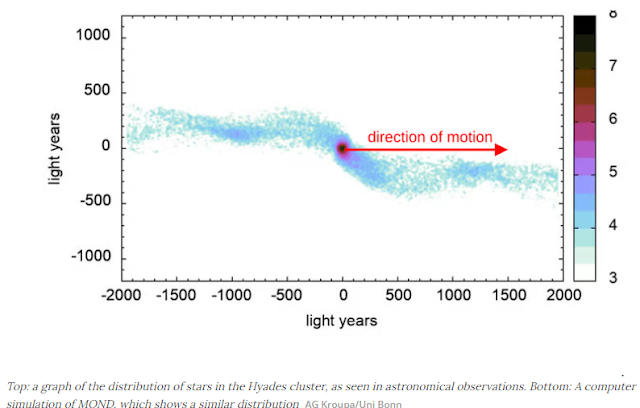Astrophysicists have
observed some puzzling behavior in star clusters that seem to defy our current
understanding of gravity at cosmic scales. Intriguingly, the observations fit
with an alternative theory of gravity that could negate the need for dark matter.
Although it’s since
been superseded by Einstein’s theory of general relativity, Newton’s law of
universal gravitation still holds pretty well as an explanation for the
large-scale structure and movements of the universe. But now, new observations
have been made that don’t quite fit these currently accepted models.
An international team
of astrophysicists had been investigating open star clusters, which contain
thousands of young stars being born from a large cloud of dust and gas. These
clusters have a relatively short lifespan before they dissolve, as the stars
drift into two “tails” – one in front of the cluster and one behind.
“According to Newton's
laws of gravity, it's a matter of chance in which of the tails a lost star ends
up,” said Dr. Jan Pflamm-Altenburg, co-author of the study. “So both tails
should contain about the same number of stars. However, in our work we were able
to prove for the first time that this is not true: In the clusters we studied,
the front tail always contains significantly more stars nearby to the cluster
than the rear tail.”
In the past it’s been
tricky to determine which of a cluster’s stars belong to which tail, but the
researchers on the new study developed a method to do so. They call it the
Jerabkova-compact-convergent-point (CCP) method, and this was applied to data
on four open star clusters gathered by surveys like the Gaia mission. To their
surprise they found that in all four clusters, the leading tail had far more
stars than the trailing one, in an apparent contradiction of Newton’s laws.
So, the team then
simulated the movements of stars in these clusters according to a different
hypothesis, known as Modified Newtonian Dynamics (MOND). Essentially, this
model suggests that gravity’s effects are stronger at low accelerations than
they are in Newton’s laws. And intriguingly, this model’s predictions lined up
very well with the observations.
“Put simply, according
to MOND, stars can leave a cluster through two different doors,” said Professor
Pavel Kroupa, first author of the study. “One leads to the rear tidal tail, the
other to the front. However, the first is much narrower than the second – so
it’s less likely that a star will leave the cluster through it. Newton's theory
of gravity, on the other hand, predicts that both doors should be the same
width.”
This isn’t the only way
in which the MOND model fits real-world observations better. Star clusters in
nearby galaxies have been found to be dissolving faster than Newton’s laws
predict – but this would be a natural by-product of MOND.
Another major
implication of MOND could shake up astrophysics as we know it – if it was true,
then dark matter wouldn’t exist. This mysterious substance was conjured up in
the 1930s to explain discrepancies in the observed motion of stars and
galaxies, which were seen to be moving much too fast for how much mass they
apparently contained. Dark matter fills the gap by adding huge amounts of
invisible mass, which scientists have been searching for ever since. Decades of
experiments designed to detect dark matter particles have come up empty.
Still, dark matter is
the prevailing theory, because it does a very good job of explaining many
observed features of the universe and there’s plenty of other evidence that
points to its existence. Although there has been other observational evidence
supporting MOND, it remains a fringe hypothesis that isn’t widely accepted by
the scientific community.
The researchers on the
new study are currently exploring other methods to produce more accurate
simulations, which could then be applied to other astronomical objects to find
more evidence for or against MOND.
Reference: Monthly Notices of the Royal Astronomical Society.







1 Comments
In 2020, I published a paper on the universe as a four-dimensional black hole: http://www.ptep-online.com/2020/PP-60-10.PDF. I also described my idea of dark matter. I think there might be a connection here.
ReplyDelete